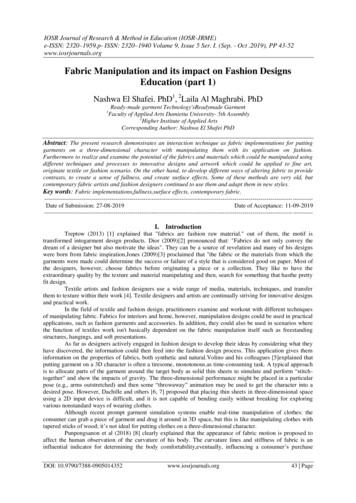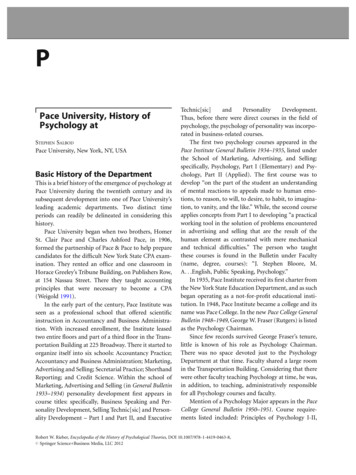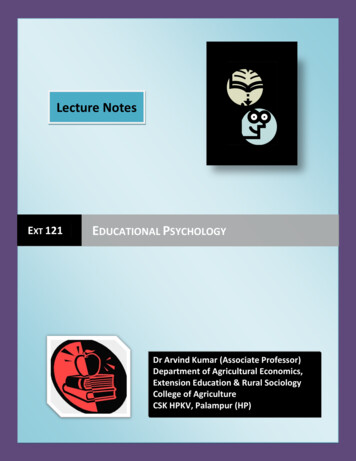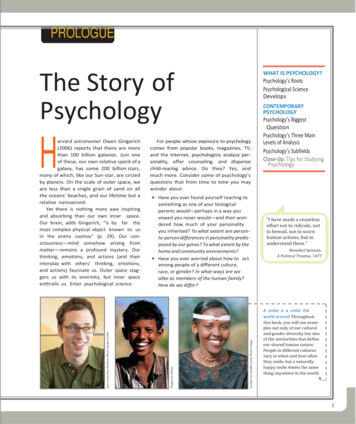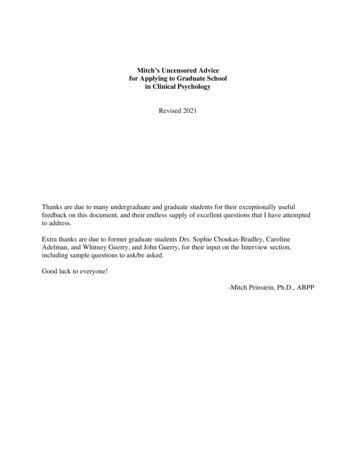
Transcription
Dark Psychology and Manipulation3 Books in 1:Improve your life by Speed Reading People andAnalyze Body Language, Influence Human BehaviorThrough Nlp, Mind Control Methods and DarkPsychology SecretsJ.R. Smith
Copyright 2019 by J.R. Smith - All rights reserved.This book is provided with the sole purpose of providing relevant information on a specific topic forwhich every reasonable effort has been made to ensure that it is both accurate and reasonable.Nevertheless, by purchasing this book you consent to the fact that the author, as well as the publisher,are in no way experts on the topics contained herein, regardless of any claims as such that may bemade within. As such, any suggestions or recommendations that are made within are done so purelyfor entertainment value. It is recommended that you always consult a professional prior toundertaking any of the advice or techniques discussed within.This is a legally binding declaration that is considered both valid and fair by both the Committee ofPublishers Association and the American Bar Association and should be considered as legallybinding within the United States.The reproduction, transmission, and duplication of any of the content found herein, including anyspecific or extended information will be done as an illegal act regardless of the end form theinformation ultimately takes. This includes copied versions of the work both physical, digital andaudio unless express consent of the Publisher is provided beforehand. Any additional rights reserved.Furthermore, the information that can be found within the pages described forthwith shall beconsidered both accurate and truthful when it comes to the recounting of facts. As such, any use,correct or incorrect, of the provided information will render the Publisher free of responsibility as tothe actions taken outside of their direct purview. Regardless, there are zero scenarios where theoriginal author or the Publisher can be deemed liable in any fashion for any damages or hardshipsthat may result from any of the information discussed herein.Additionally, the information in the following pages is intended only for informational purposes andshould thus be thought of as universal. As befitting its nature, it is presented without assuranceregarding its prolonged validity or interim quality. Trademarks that are mentioned are done withoutwritten consent and can in no way be considered an endorsement from the trademark holder.
Table of ContentsHow to Influence PeopleIntroductionChapter 1: The principles of persuasionChapter 2: Difference between influence and manipulationChapter 3: The tools and techniques used to influenceChapter 4: Explain how the environment affects our brain developmentChapter 5: Communication skills improvement and influenceChapter 6: How to use empathy for better communication and influenceother peopleChapter 7: Tips to help people become a better friend, a better parent, abetter partner, better businessman or women, outlining the beliefs or mentalhabits that one person should cultivate to use successful negotiationmethods in daily life situations.Chapter 8: Influence in dating and relationshipsChapter 9: Influence of friendshipChapter 10: Influence in parentingChapter 11: Influence at workplaceChapter 12: Influence in advertisingChapter 13: Influence on religionChapter 14: Provide knowledge ethically dealing with other people’semotions.Chapter 15: Tips and checklist to spot and stop manipulators.Chapter 16: How to detect deceptionChapter 17: Tips and workout to increase self-esteem in order to avoidbeing manipulatedChapter 18: Illustrations of manipulation and ways of defending against itChapter 19: Guide to dealing with bullying behaviorConclusion
NLP Dark PsychologyIntroductionChapter 1: Neuro-Linguistic Programming and Mind MapChapter 2: Understanding the Dark TriadChapter 3: Manipulation and Behavior ConversionChapter 4: Simple Mind Control Techniques to UseChapter 5: Personalities Likely to ManipulateChapter 6: NLP and DepressionChapter 7: NLP and AnxietyChapter 8: Subliminal PersuasionConclusion
Dark Psychology SecretsIntroductionChapter 1: The History of PersuasionChapter 2: The Psychology of ManipulationChapter 3: Dark Psychology TacticsChapter 4: Dark Persuasion and DefenseChapter 5: How to Read PeopleChapter 6: Skills and ToolsConclusion
How to Influence PeopleA Guide to Develop Mind Control Techniques,Learn how to Win Friends and Influence OtherPeople, Discover the Secret to Defend Yourselffrom Brainwashing and DeceptionJ.R. Smith
IntroductionMost of us want to influence people around us and beyond. Influencingpeople may have appeared as a forte reserved for some people but the entryof this book will systematically guide you. In a highly structured andinformative manner, the reader is introduced to the principles of persuasion,the difference between influence and manipulation as well as the tools andtechniques used to influence. A reader is walked through how theenvironment impacts brain development to help appreciate why somepeople may be vulnerable to manipulation while others are goodinfluencers. Since manipulation and influence relates to interacting withpeople, the environment plays a significant role in how one navigatesmanipulation as well as influence. As expected, the book underscores therole of communication skills in accomplishing influence.Additionally, the book explores what constitutes empathy and its criticalrole in communicating effectively. The other interesting area that the authorexplores is providing tips to help people become a better friend, a betterparent, better partner, better businessman or women, outlining the beliefs ormental habits that one person should cultivate to use successful negotiationmethods in daily life situations. Another topic that most people will finduseful concerns ways of exerting influence on dating and relationships,exerting influence in friendship, and exerting influence in parenting. Mostof us want to exert influence at the workplace, which can increase our lifechances, and for this reason; the author dedicated an entire chapter to helpthe reader learn ways of exerting influence at the workplace.
Chapter 1: The principles of persuasionMost people would wish to influence others. Influence is the least cost andyet effective ways to make masses of people obey your wishes where thewishes are meant to mutually benefit all. Influence can be inborn or learnedas a skill or both. Think of wooing voters without having to spendsignificant sums of money to sway them. Imagine a situation where yousway the management to buy into your ideas and drop their hardline stance.While all these appear reserved for certain people, it is possible toaccomplish influence by exploring and integrating the Robert Cialdiniprinciples of influence.ReciprocityThe fundamental principle of influence is to simply grant that which youwant to receive. In other terms, doing right by others is a great way to makethem return that favor. The principle of reciprocity is a potent one.Reciprocity can be expressed in multiple ways such as giving others smallgifts, doing favors for those in need, and treating others with respect and areall things that can earn you points with other individuals. For this reason, arecommended approach is to always help others and remain kind when theyhave an opportunity, as there is likelihood that you will need their help inthe future. It is these small acts of kindness that will be remembered andbecome useful when one needs a favor.ConsistencyRegarding the principle of consistency, it is anchored on the power of activeand voluntary commitments that leads to people abiding by their word. Forthis reason, let us explore these requirements in a detailed manner. The firstaspect is an active commitment and by active it implies that something thatis written or spoken to other people. The start of persuasion is makingpeople say that they will do a particular thing. When an individual commitsto something then they are much more likely to follow through. The nextstep is to make the declaration public. If other people witness thecommitment, then the level of accountability is likely to be enhanced and inmost cases, no one wants to retract. Lastly, the commitment has to bevoluntary because if you force someone to make an active and public
commitment that they did not decide on themselves then you will haveaccomplished nothing.Social proofWe rely on social cues from others on how to think, feel and act in differentsituations. Peers lead in an exhibition of social proof among the generalpopulation. Social proof then refers to a person depending on social cuesfrom others on how to think, act and feel in different situations. Against thisbackdrop, one is likely to use a particular intern in their department toinfluence other interns by first orienting the selected intern to idealattributes. When other interns see another employee like themselves, theyare likely to mimic or adapt to that behavior. It is thus important to get oneof the target people to exhibit the desired action or attributes to influencethe others.LikingMost people prefer those individuals that like them or who view them asfriends. Although simple, this is a powerful concept. We can use theprinciple of liking in several ways. First, one can find common ground withthe individuals he or she meets. If one can connect with such people ontheir interests or hobbies then one will have promising ground to start from.One should be observant of people to notice any clues that may make onediscover shared understanding. The second means of inviting the liking ofanother person is to make genuine praise. Praise that is exaggerated isconsidered a flatter and somehow dishonest. However, paying complimentsand being charming can help one build a positive rapport with other people.One mustn't overdo paying compliments. For emphasis, the praise accordedto the target individual should be genuine.AuthorityIf people perceive you as an authority in an area then they are likely to deferto you. Most people consider experts as capable of giving shorter buteffective approaches to complex issues that would see other people takelonger to accomplish. Against this backdrop, one should seek to establishthe credibility of authority and expertise before seeking to influence thetarget masses. Most people miss this window of opportunity since they
assume that others will notice their expertise automatically. For this reason,you should explicitly make the target audience aware of your expertise.Authority can be established in several ways. For instance, make all youracademic credentials and awards visible to your target audience. Authoritycan be established by making short anecdotes as well as backgroundinformation shared in casual conversations. For emphasis, your expertise isnot always a known quantity and one should convey it when the chancepresents.ScarcityExpectedly, people value what is rare or scarce. Nothing strange as thisperfectly satisfies the law of supply and demand because as things becomescarce, they become more valuable to others. The principle of scarcity canbe applied to convince others. One approach is to make offers limited-time,limit supply, or one-time with creates a perception of scarcity. How onepresents such opportunities counts in that if one focuses more on losslanguage then the message becomes more potent. Then there is theexclusivity approach which concerns granting access to services,information, or other items to a limited set of people elucidating a sense ofexclusiveness. The goal is to get the target audience to translate all these asa favor extended to them or that you are valuing them more than others. Ifone combines all of the above approaches then his or her powers ofinfluence will significantly increase.IllustrationsWhen one goes beyond the expectations when dealing with another personthen the person is offering more than needed. Human beings are rationaland will promptly notice that they have been given more care or servicethan should be the norm. By offering more than expected, you are takingthe lead of the current and future interactions with the target person. Mosthuman beings have learned to offer back in equal measure when they getextra care and concern from others. The overall aim of the principle ofreciprocity is that it makes the other person feel that they owe you for whatyou did to them even when not asking for it. By being generous withempathy, concern and physical gifts you are chaining the target person toconcede more in future interactions. Through reciprocity, you build trustand propagate the relationship.
Regarding, the principle of scarcity, people are drawn to that which isdifficult to find as it is considered rare, exclusive and unique. Scarcitymotivates an individual to make the best use of the limited opportunity.Have you ever wondered why most politicians will maintain their presenceminimum even when they have no justification to appear briefly? Thereason for this is that scarcity makes the target entertain the perception thatthe individual is highly valued and his or her appearance should beappreciated. All these developments increase the eagerness to listen andbelieve the politician. On a personal level, if your partner or spousesuddenly withdraws chances are that you are likely to want to feel theirpresence more. The art of limiting your availability helps enhance yourvalue as a person as well as your opinions and a good influencer creates theperception that he or she is highly sought after.For the principle of authority, people tend to coalesce around figures ofauthority and this is the primary motivation for using celebrities to endorseproducts. Companies spend significantly to get a celebrity or a recognizablesporting personality to endorse their product because the target masses viewthe celebrity as an authority in that domain. In formal contexts, figures ofauthority may include accomplished engineers, doctors, and journalistswhose opinion is seen being the most applicable option. Fortunately, theprinciple of authority allows any person to create the perception of authorityand get the target audience actively listening and implementing what he orshe says. As indicated, one should start by making the audience aware ofyour credentials to enhance your credibility. One can also use memorizationto make the audience feel that the individual is well furnished with thetarget area.Relatedly, ensuring that you are consistent is important as it helps carve outthe image that you are aware of yourself and are principled. No one wouldwant to follow an individual that switches sides during an argument or acrisis. People appreciate consistent people and are likely to believe themeven when earlier on they dismissed such people. There are chances thatyou voted for a political candidate that appeared to have a stand even therewere sufficient factors to make you reconsider your views. Take a look atmost adverts of a particular product; they try to maintain consistencyconcerning the utility that the product provides to the end consumer. Forinstance, try to review the adverts about Dettol soap and you will realize
consistent is sustained. The other benefit of creating consistency is that itmakes your target audience associate specific values with you even incontexts where you are not present.Then there is the principle of consensus and a leader that allows forcompromise can illustrate this. Chances are that you find a leader that iswilling to strike a middle ground during conflicts as an understanding andhumane leader. Compromise helps create the impression that one isunderstanding and can relate to how you are feeling. People tend to findpersons that exhibit ideal human qualities such as empathy as honest.
Chapter 2: Difference between influence andmanipulationExpectedly, the influence that is misused for selfish gains qualifies to bemanipulation. Manipulation is the deliberate application of influence foryour gain at the expense of others while influence seeks to promote greatergood by helping herd people in a particular direction. For instance, if youwant people to drop certain cultural practices that are retrogressive then youwill employ tactics that will make them believe your views. However, ifyou use the stated techniques to convince people to make themunknowingly help you attain your interests then that is manipulation.Overall, the primary difference between influence and manipulation is themotivation for convincing people.IllustrationWhat is its influence?Assume that Brian is at a restaurant with friends and after finishing themeal, he pays the bill for everyone without asking anyone to do it. Assumethat Brian does this a couple of times. The next time Brian and friends go toa restaurant again, someone else foots the bill without asking others to chipin. In this manner, Brian has influenced others to follow his habit eventhough nonverbally.What is manipulation?Again, assume that Brian is at a restaurant with friends and just before thebill is brought, Brian pretends to be checking his pockets and says that heforgot his wallet. Brian does this a couple of times and no one asks Brian tofoot the bill anymore. In this manner, Brian manipulated his friends to stopconsidering asking him to foot the bill.For this context, the negative influence is manipulation. It is possible toinfluence people to do something that will harm or negatively affect them.For instance, you can influence your colleagues to elect a workplace leaderwho is ineffective because you dislike the company. In this case, yourhatred for the organization has made you employ techniques of persuasion
to make your colleagues elect an individual that will not perform toexpectations. You have driven people to make a decision that willnegatively affect their future at the organization just to satisfy your dislikeof the organization. The rest of your colleagues are unaware that you werenot genuine when urging them to vote in the current leader.Additionally, with manipulation one is aggressive and will not allow thepersuasion to develop gradually because of selfish intent. Influence isgenuine and one is likely to allow it to manifest naturally but withmanipulation, one wants to exploit the slim chance to realize selfishinterests. For instance, a manipulator will exploit the fact that there is goingto be a change in leadership at the organization and advance his influence tomake workers vote in the least deserving leader. The motivation forinfluencing others to make an unwise decision is to ensure that theorganization has little chance of getting effective feedback about thewelfare of the employees and eventually face a mass exodus ofresignations.Relatedly, manipulation depends significantly on reading and exploitingbody language while influence relies more on verbal cues ofcommunication. For one to effectively manipulate people, he or she has toevoke appropriate facial expressions, tone of voice, posture, eye contact,and paralinguistic techniques. In other terms, manipulation requires timingfor it to succeed while influence is less restricted and verbal cues ofcommunication are enough to accomplish persuasion.Unlike influence, a person manipulating others will feel dishonest andselfish if others found that he or she deliberately persuaded them. Whileboth influence and manipulation may be subtle, a manipulator fears beingexposed. A person seeking to influence others is comfortable should he orshe be exposed since the persuasion is meant for mutual wellbeing of thoseaffected. Unlike a person seeking to influence, a manipulator continuouslyseeks to sustain the status quo once he or she manages to control the targetpeople.Additionally, an influencer seeks to sway each person in the target audiencewhereas a manipulator focuses on simply attaining the selfish goal throughpersuasion. When manipulating people the intention is to simply attain your
target goal and not to persuade each of the affected people. For this reason,once the manipulator feels that his or her plan is on track then the individualwill not consider other people that are not impacted by the manipulation. Amanipulator tends to get interested only in individuals capable of exposingthe selfish intent of the manipulator and for this reason; a manipulatordifferentiates the audience to manage it. On the other hand, an influencerseeks to win everybody to his or her side and is not scared of dissentingvoices.One can also view manipulation as seeking to make the job of themanipulator easier while making the affected job harder. In somecircumstances, a manipulator exploits others to enable him or she has aneasy time while the affected people face difficulties executing theirmandate. In such circumstances, manipulation seeks to dim the performanceof others while elevating the perpetrator's performance. A manipulator inthis context seeks to attract all the attention to his or her direction andexhibits sadistic attributes.More illustrationThink of a student leader that breaks the code of conduct in a university.The student leader knows that he or she will face the disciplinary committeewith the possibility of being suspended or expelled from the learninginstitution. However, the student leader understands that he or shecommands significant support among the students and a section of the staffat the learning institution. The student leader then chooses to exploit thefact that a lot of students and a section of the staff will listen and believe hisassertions and whips up the emotion of students and some of the staff. Allthese developments help precipitate a crisis at the learning institutionmaking it difficult for the administration of the university to hold thestudent leader accountable for the violation of the code of conduct. In thiscase, the student leader is a manipulator. A manipulator avoidsaccountability when cornered and instead prefers to precipitate a crisis.Now assume that the student leader is exposed as having used his influenceamong the students and a section of the staff to shield himself fromdisciplinary action. Chances are that the student leader would feel like afraud and the affected would feel used for selfish gains. Again, the studentleader cared not for anyone except for his interests a high likelihood. For
instance, the student leader cared not for the implication if some studentsare let go without accounting for their misbehavior at the institution.Another illustration of manipulation concerns the case of Alex who loathesthe administration of his organization and yearns to make them feelcornered. Even though Alex puts on a face of a composed and disciplinedemployee, he is not. It happens that one unfortunate day, one of the workersis attacked by the security dogs in the compound of the organization. Alexthen sees a rare opportunity to turn the workers against the management. SoAlex whips up the emotion of employees and makes them feel that they areinsecure and their welfare not adequately taken care of. The colleagues ofAlex innocently believe that Alex's views are genuine and meant to helpelevate their safety at precincts of the organization. From this illustration,Alex is a manipulator who takes advantage of an emotive situation toaccomplish his interests devoid of the interests of the majority.Again, Alex most likely cared not for the welfare of others but only his.Alex is not bothered about the reputation or longevity of the organizationand its impact on the workers. In other words, if the organization wasforced to suspend operations and laid-off workers then Alex would not bebothered that his colleagues are jobless. For Alex, as long his selfishinterest triumphs then nothing else matters. Alex would also feel unease andashamed if his selfish interest was exposed in all these developments.On the other hand, influence can be demonstrated by Sharon'sdetermination to make the community safe by having parents get activelyinvolved in the lives of their teenagers. At first, Sharon realizes that fewpeople are listening to her campaign to make parents more involved in thelives of their teenagers. Sharon then resorts to persuasion tactics by makingthe community notice her profession as a psychologist and gives themrespect and attention to which they reciprocate. Sharon consistentlycommunicates her message and campaign across the neighborhoods of thecommunity and goes further to use one of the mothers actively involved inthe life of her teenagers as an example. With time, the entire neighborhoodsways to the message of Sharon. All these development indicate influence,which is the deliberate persuasion of people to align with your message andintentions for mutual gain.
Chapter 3: The tools and techniquesused to influenceConventional tools used to influenceThere are various techniques and tools used to persuade people. The varietyof techniques and tools employed to convince people to enable one to adjustpersuasion tactics depending on the environment and the target audience. Itcan be argued that different tactics to influence an audience will varydepending on their age, level of education, place, ethnicity and religiousaffiliations. Conventional tools refer to widely acceptable methods andtechniques to persuade people. These tools are conventional in that theyelicit the least ethical protest on their usage. In this chapter, we are going topresent the specific tools and techniques used to influence.Logical persuadingUsing this technique, one employs logic to explain what they want orbelieve in. Using logic to persuade is a fundamental tool to appeal topeople. Logical persuading is widely practiced and is effective but it doesnot work for every person. In this technique, the influencer makes the targetaudience appreciate the suggested direction as the most reasonable, efficientand safe. Once the target audience has bought this line, they will in turn actas mini-influencers by recruiting more people to the suggested line ofthought. Logical persuading is widely used by political leaders especiallywhen seeking to unseat the incumbent. In conflict resolution, logicalpersuading as a technique tends to deliver.LegitimizingLegitimizing implies appealing to authority. Legitimizing is the leasteffective technique to influence. One of the reasons for this technique isineffective is that it takes attention away from the speaker and grants it to arecognizable authority. For this reason, appealing to authority may appearas an attempt to intimidate the audience. The second reason for thistechnique showing ineffectiveness is that it makes the target audience awareof the attempt to manipulate them. Consequently, the audience invokes thedefense mechanism against explicit manipulation. However, legitimizing as
a technique will work for most people and can elicit quick complianceespecially in the formal settings.ExchangingIn this context, exchanging techniques entails mediating or trading forcooperation and is most efficient when it is contained. In somecircumstances, exchanging or compromise is the best way to persuade anaudience. A shrewd influencer will create a perception of a standoff orcrisis and offer the audience compromise which elevates the liking for theinfluencer. The underlying principle of the exchanging as a technique is toenable the participants to feel involved and appreciated rather than bepassive participants. In conflict resolution and business negotiation,exchanging as a technique is widely preferred. However, using exchangingtechniques should be limited to deserving contexts lest it qualifies asmanipulation.StatingThe technique of stating asserts what you want or believe. It is one of thepersuading tools and most sufficient when one is self-confident and statesideas with an imperative tone of voice. In this technique of influence, onesimply makes the audience aware of what he or she wants. In some contextssuch as the church and school, this technique of influence works.Concerning power relations, stating as technique works where the targetaudience has no negotiating power when placed against the influencer. Forinstance, a principal of a school informing students on the need to keep timeand submit homework constitutes an application of the stating technique ofinfluencing. Stating can cause resistance if overused. The resistance tostating, as a technique is that it can create the impression that the rest of theaudience is expected to align with the influencer and that they do not havethe freedom to differ.SocializingThe technique of socializing concerns getting to know the other person andbeing open and friendly. It is about finding common ground. Socializinginvolves complimenting people and making them feel good aboutthemselves. Socializing is a critical influence on power tools and is widely
applicable across different settings. Most politicians employ socializing byreducing themselves to the routine life of their voters which makes themrelatable and believable. Ever thought why most political candidates duringcampaigns freely interact with the common man and even ride bicycles?The reason for this is that they are trying to socialize by appearing open andfriendly.Appealing to the relationshipThe technique of appealing to relationship involves cooperating with peoplethat you already know well premised on the length and strength of theactual relationships. The appealing to the relationship as a technique toinfluence is among the most effective persuasion tools. Creating arelationship enables to create a lasting influence as the participants feel thatthey owe the influence of cooperation and reciprocation. Think of whyteachers invest significant mental energy in helping a connection withstudents. The reason for investing in a relationship is that the targetindividual readily accepts the pers
Most people would wish to influence others. Influence is the least cost and yet effective ways to make masses of people obey your wishes where the wishes are meant to mutually benefit all. Influence can be inborn or learned as a skill or both. Think of wooing voters withou



